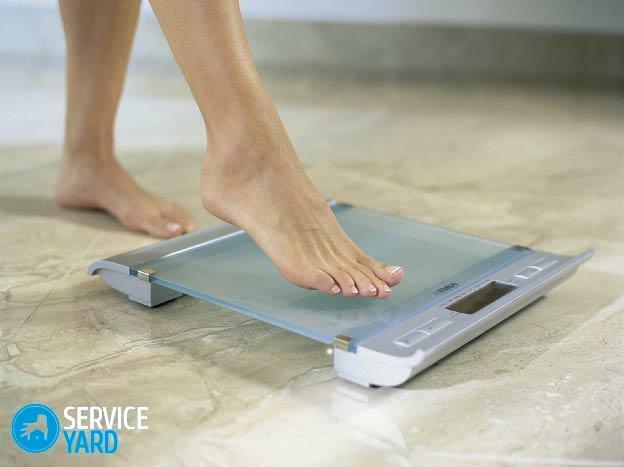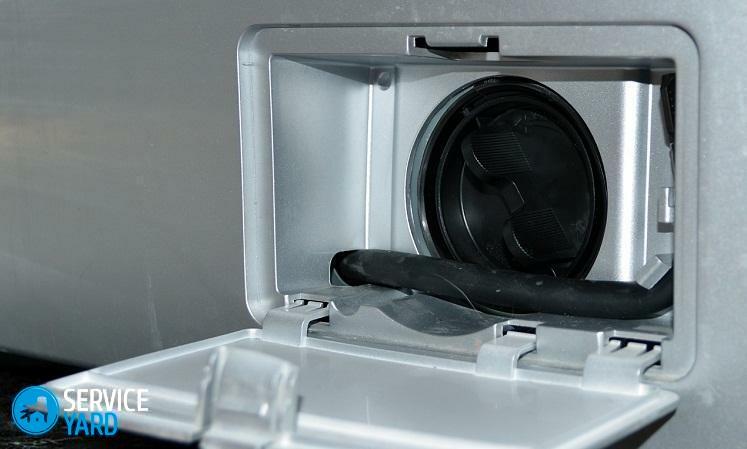During welding, the electric arc emits light identical to the solar one. This implies UV rays. Without a special protective mask, all welders would receive light burns of the skin and cornea of the eyes. Thanks to this practical accessory, you can protect your face and head from the effects of ultraviolet rays and the ingress of scale.
Modern masks have a wide variety in price and quality. In order not to overpay, but also not to buy a protective device again after half a year, it is worthwhile to understand the key characteristics of the welding mask and to choose the most suitable for a particular type of activity.
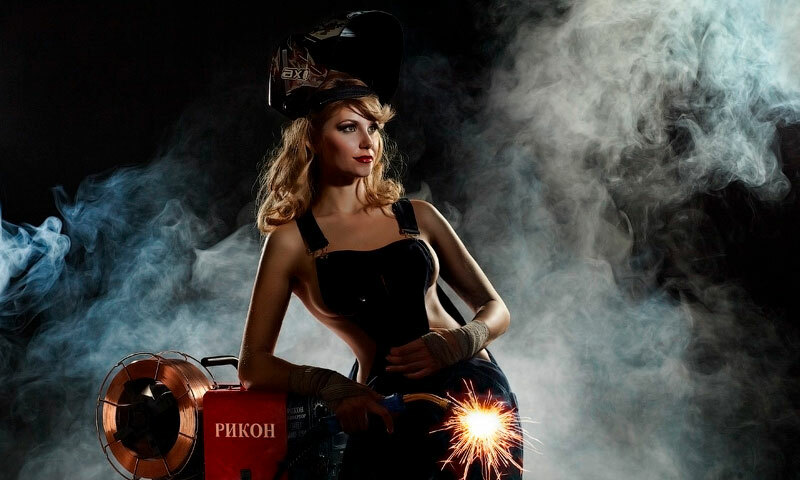
Contents:
- The best manufacturers of masks for welding
- The principle of operation and the welding mask device
- Varieties of masks for welding
- Welding mask selection parameters
- Which welding mask to choose
- How much does the welding mask
The best manufacturers of welding masks - Which company to choose
Forthose who do not have the time to research this issue, you can choose one of the following firms-leaders in the production of welding masks:
1. Fubag
2. Inforce
3. Patriot
4. "Zubr"
5. "Resanta"
But in view of the significant differences in specific models and suitability for certain conditions, it is worth familiarizing yourself with the rating of the best welding masks. This will help to see the pros and cons and narrow the choices.
Well, to understand everything yourself, to weigh various factors and make a decision, the information below is provided with a detailed analysis of the key parameters.
Principle of operation and welding mask device
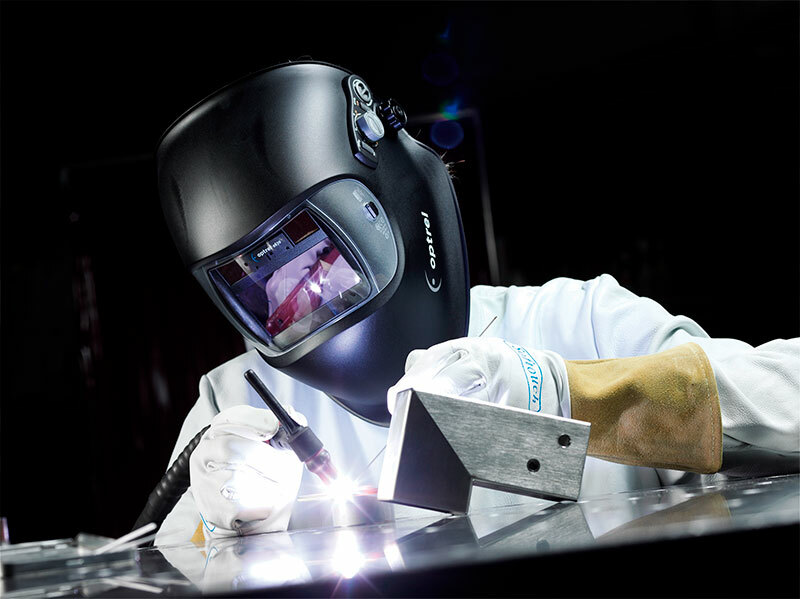
Mask for welding is designed to protect the worker from a number of harmful factors. The electric arc radiates ultraviolet radiation and a large amount of heat, which harms the welder's skin. Constant monitoring of the formation of the seam can lead to severe burn of the cornea and blindness. During the melting of the metal, some impurities can be released and bounced off in the form of burning scale.
A melting electrode with coating and the edges of the welded surface emit toxic fumes, which are necessary to protect the weld pool from the effects of the external environment. The inhalation of such gases is also dangerous. Therefore, for more than a hundred years, designers have been working on improving the shape and function of the welding mask, designed to protect the specialist from this series of negative factors.
Another, an accessory, put on the head, completely releases hands, so that the welder can independently hold the part and weld it with an electrode in the second hand. This increases productivity and reduces the number of busy people in one process.
Welding masks are used everywhere: in factories, service stations, repair shops and in the private sector when working in the country( fencing, wicket, shower).A wide variety of prices allows you to purchase this accessory for everyone, even if you cook once a year.
Most types of welding masks include the following elements:
- casing with an elongated part for neck protection and a semicircular cutout at the top for free lifting;
- viewing window with a conventional glass( lens) for obstruction to UV rays and observation of the process;
- light filter, which protects against bright flashes;
- solar panel for recharging batteries from arc light( for chameleons);
- dimmer filter dimmer;
- head retainer.
The light filter is the main protective element of the mask, it is a glass with a black coating. In daylight, it's impossible to see anything in it. But when the electric arc lights up, the edges of the weld metal and the place of electrode melting become clearly visible. The outlines of the surrounding details are partly manifested. Depending on the place of work, the degree of darkness of the light filter also differs.
Some models have a folding window that allows you to raise the dark glass and look at the seam without removing the entire mask. This slightly improves performance and makes it easier to use. But these masks weigh more, which increases the burden on the neck.
In other models, the light filter is made of two glasses, between which are liquid crystals. In the normal state, they are perpendicular to the plane and allow the welder to see what is happening as through conventional sunglasses. But when the arc is ignited, a small current in the mask device is triggered, and the crystals are rotated 90 degrees, which darkens the filter to the desired level, and through it only welding can now be seen.
Modern masks can be made of pressed cardboard or heat-resistant plastic. Most often they are painted black or gray, but foreign manufacturers use bright yellow and red cases. This contributes to a greater light reflection, and also makes the welder more visible to workers of crane beams and bridge lifting devices.
Types of masks for welding
Depending on the required safety and ease of work, the types of welding masks are also different. They can be as follows.
Simple( standard) masks
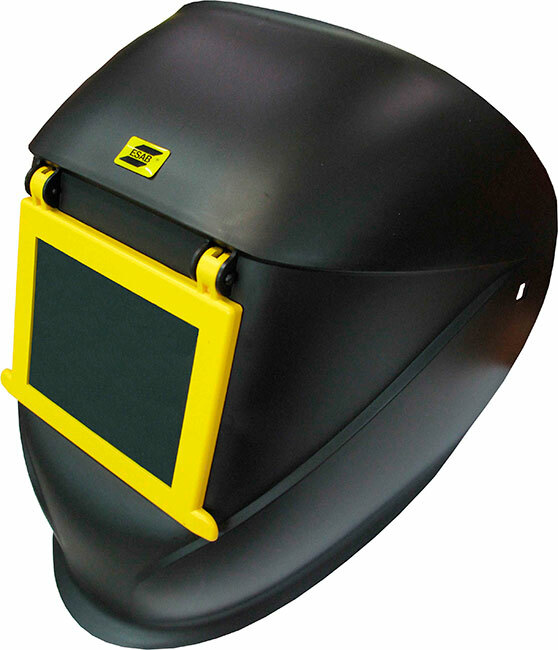
Made of pressed cardboard or poured from plastic, resistant to high temperatures. Most often have a small viewing window and a budget fastening without a soft substrate. Paper models are much lighter than plastic ones. The light filter is installed in a special unit behind the protective glass and fixed from above by a clamp to prevent falling out.
To change the degree of darkness of the filter, it is necessary to remove the accessory from the head, unscrew the block retainer and replace the black glass with an element with a larger value. Such masks are cheap and suitable for novice welders or small organizations, where many welding jobs are performed in the lower spatial position.
Advantages:
- is cheap;
- cardboard versions are light;
- filter protection at the proper level in accordance with GOST;
- can be operated at any air temperature;
- there are models with observation viewing windows.
Disadvantages:
- plastic cases are heavy;
- cardboard mask can swell from moisture;
- head mount solid;
- there are very large casings that are inconvenient for welding in hard-to-reach places.
Chameleons
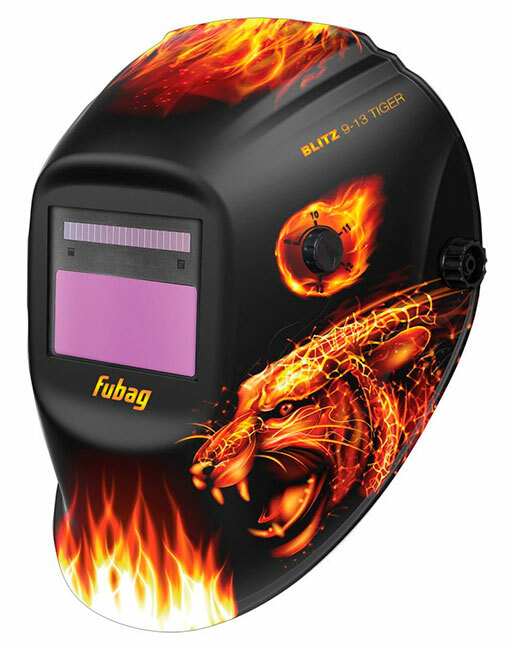
This is a more expensive type of masks containing a screen with liquid crystals. It is convenient because the welder does not need to constantly lift the accessory up after each seam to assess the quality of work and see where to start the next joint. Crystals automatically make the glass transparent after the arc is interrupted.
To adjust the dimming level it is enough to turn the switch on the left side of the case, which can be done without interrupting the burning of the arc. The electronic circuit operates from the battery and is powered by the light of the welding itself. Such masks are suitable for those who perform many small seams and who often need to navigate the product. Especially this kind of protective device is popular with argoners.
Advantages:
- smooth and quick adjustment of light-darkening;
- soft mount;
- beautiful design;
- heat resistant housing;
- is easy;
- lining on the forehead impregnated with antibacterial composition;
- long service life;
- availability of guarantee.
Disadvantages:
- crystals do not work well at low temperatures;
- is expensive;
- is more suitable for argon, due to rapid contamination of the scales of the front glass from welding with coated electrodes.
Masks with forced air supply
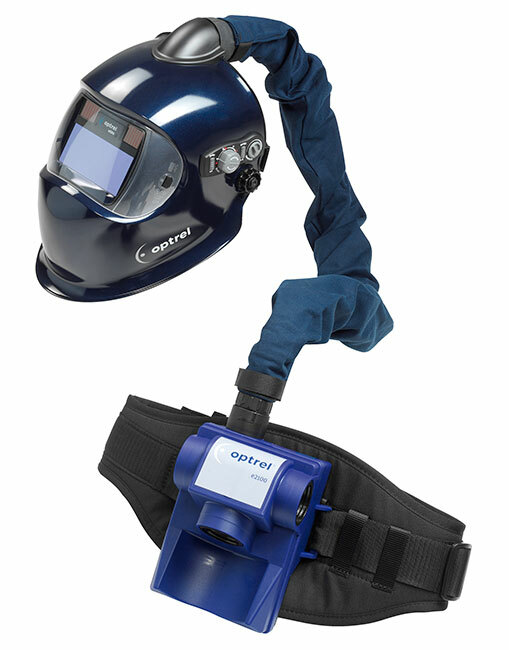
During welding, gases emitted from the molten electrode and the product to be connected to the air. Under normal conditions, it is sufficient to have a hood above the workplace to remove harmful smoke. But sometimes welding work has to be done inside a confined space( large capacity, small basement room without windows).Then it is necessary to use a mask with forced air supply to the respiratory organs.
It works by the principle of a respirator, which is attached to the back of the worker on the back. A small electric motor tightens the surrounding air, filters it through a protective system and feeds it through the hose directly under the mask. This design requires additional equipment, but it allows safe operation under specific conditions.
Advantages:
- reliably protects from harmful gases;
- allows you to work in difficult technical conditions;
- has good light filters;
- high visibility;
- convenient adjustment of fastening;
- is a large range of dimming values.
Disadvantages:
- high cost;
- can be caught with a hose for protruding objects;
- in some models, the upper branch pipe is high, which creates additional difficulties for passage into bottlenecks;
- additional costs for filter and batteries.
Welding mask selection parameters
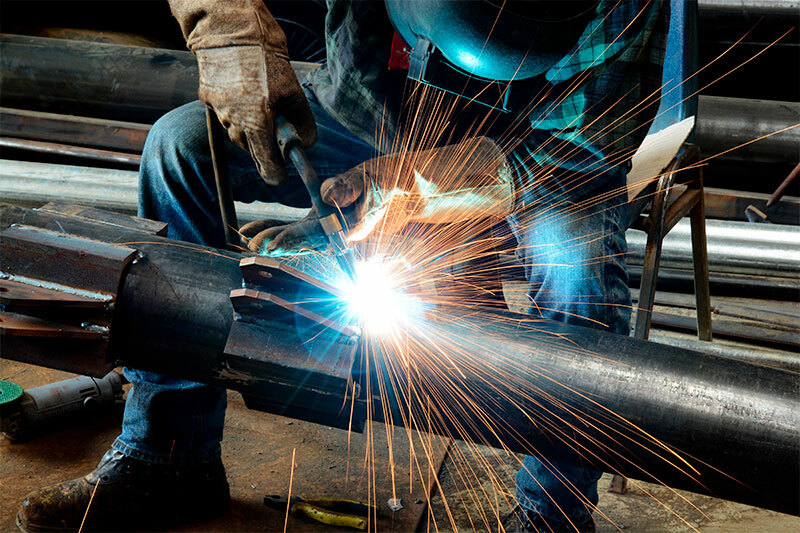
The welding accessory has many selection parameters that determine the place of use of the protector and convenience for the welder. To buy the most suitable mask, you need to take into account the criteria below.
The size of the viewing window
The screen of the welding mask is indicated in millimeters and is from 90х32 mm to 110х93 mm. On this depends on how well the welding bath will be seen to a specialist. For those who perform work in the lower position and have the opportunity to look directly at the welding zone, a small viewing window of 90x30 or 90x40 mm is sufficient.
Employees of utilities, who have to cook pipes close to the wall or floor, need a screen 110x60 mm. Those who constantly work inside large tanks or with ceiling welding, need windows enlarged vertically to 100x90 mm. With a small screen you have to twist more with your neck, and because of the limited space it can be difficult, and quickly tired muscles.
Degree of dimming
In standard masks, the light filters have numbers from 2 to 5 units. If such a model is used, then a maximum score of 5 is needed to work in the yard. In a room through such a glass it will be difficult to discern what is happening in the welding bath and then buy masks with a light filter №3-4.In very dark conditions( cellars, boilers of huge furnaces), a protective element No. 2 is needed.
In chameleons, the scale of light-darkening is denoted in DIN and is from 5 to 15. Since these masks have a degree of crystal turn adjustment, it is necessary to choose an accessory with a range of 9-13.The upper values will be enough to work on the street, and the lower ones will suffice for the workshop or garage. Indicators from 5 to 8 DIN are used in very dark conditions or by welders with poor eyesight.
Weight
The weight of the welding protective accessory can be from 0.35 kg to 0.9 kg. This is influenced by the type of casing material, the thickness of the glass used, fastening and additional devices. The smaller the weight, the more convenient the welder. Still it will reduce the negative load on the cervical vertebrae, because often experts lower the mask with a sharp nod of the head, because the hands are already occupied by the holder with the details and are set to the exact beginning of the seam. But it's all important for professional use. In the case of giving and welding, once a month any mask, even 0,9 kg, will do.
Filter type
Conventional dark glasses are well suited for arc welding with consumable electrodes, because they are covered with a cheap protective glass for frequent replacement, due to splashing slag on its surface. This is a good option for beginners or in the case of dacha use.
Chameleons with liquid crystal screens should be chosen more by welders engaged in argon apparatus, where welding is carried out by tungsten electrodes without splashing. This mask improves productivity, helps to quickly change the welding zone without removing the accessory, and allows you to accurately start the place of a new seam without unnecessary marks from the arc. This is a choice for professionals employed in auto repair shops, firms for the manufacture of heated towel rails or a scientific research institute for the creation of water treatment systems.
Power type
In the case of a chameleon, a liquid crystal screen should receive energy to trigger the sensors and turn the position of the fine particles that darken the filter. All such masks have a built-in battery, which will have to be changed periodically. Other models are supplied with an additional panel for absorption of light rays from welding and battery charging system, so their resource is much greater. But with rare work, the battery is discharged, and the first time, when welding is resumed, the filter does not work. He needs to be given time to recharge from the sun.
For those who buy a chameleon to create accurate connections, but do not plan to do it every day, a one-battery model will do. This mask is always ready for use. In the case of permanent employment it makes sense to purchase a protective element with a solar panel.
Case form
This parameter is responsible for safety and its properties can only be checked in practice. Visually the shape of the casing should have good streamlining and an elongated part from the bottom, so that the welding smoke does not fall into the welder's face. The upper edge of the mask is desirable with a small semicircle, but sufficient height to prevent the scales from getting on the head. The width of the accessory should not exceed 240 mm for those who work with pipes in bathrooms, boiler rooms or cellars to maximally cling to the wall and see the far edge of the joint. In other cases, the width is unimportant.
Body material
Pressed cardboard is much lighter, but it can swell from moisture, so these masks are bought for indoor or warm seasons and for welding in the yard. Plastic casings are massive and serve a long time, but putting them on the newly welded joint can no longer be torn off( the plastic will melt and adhere to the hot metal).They should be purchased for work on the street and for those who have a special place with a litter to store the accessory during off hours.
Triggering the chameleon
When the arc is lit, the crystals should instantly turn around and have time to protect the eyes from the bright light. Given that the speed of the last 300,000 km / s, sensors and other elements do it in a very short time. This parameter can only be checked by personally turning the light filter on welding or bright sun. If the eye manages to capture the light, then this is a bad mask, from which vision will suffer.
In most chameleons, there is a delay function for 1-2 seconds to reverse the rotation of the crystals, which should be taken working in very dark conditions( large tanks, night work), since the light from the solidifying metal after the end is very bright and can dazzle.
Availability of
settings Masks with adjustable electronic dimming have a wheel to select the level of protection from light. In some models, it is inside, next to the frame of the viewing window. For other accessories, the regulator is located outside the left side of the body and can be twisted even during welding.
The first option is suitable for working in the same conditions( workshop, block, garage).The second option is useful for working on the road or with a shifted schedule and will allow you to quickly adjust and adjust the darkness to the hike of the new environment.
Convenience of fastening
The mask is fixed on the head of the welder with two plastic rims, one of which covers the circle, and the second limits the depth of fit. On budget models such plastic is not isolated in any way and it quickly rubs the forehead. This option is suitable for infrequent work in the country or in the garage.
Professional models are supplied with foam pads that soften friction and pressure from the accessory. Some manufacturers impregnate the material, which comes into contact with the forehead, antibacterial composition, which reduces irritation. Of course, such types of fastening should be chosen for permanent wearing of the mask for 6-8 hours.
Distortion of the lens
Serious sellers accompany the product with a certificate and documents. In them, as well as on the body of the product, there should be a designation of the degree of distortion of the optical lens. It is prescribed by the first digit in the line through the slash. A value of 1 means minimal distortion and is necessary for those who work with thin products, where narrow narrow seams( small heat exchangers, oil dipstick tubes) are required. For welding thick pipes or sheets of metal, the distortion factor is sufficient. 2.
Light scattering
This parameter indicates the transparency of the screen and the ability to clearly see the details when burning the arc. It is written down by the second digit in the line through the slash. The value of 1 is necessary for those engaged in welding thin-walled metal( less than a millimeter).For all other works, figure 2 is suitable.
Which welding mask to choose
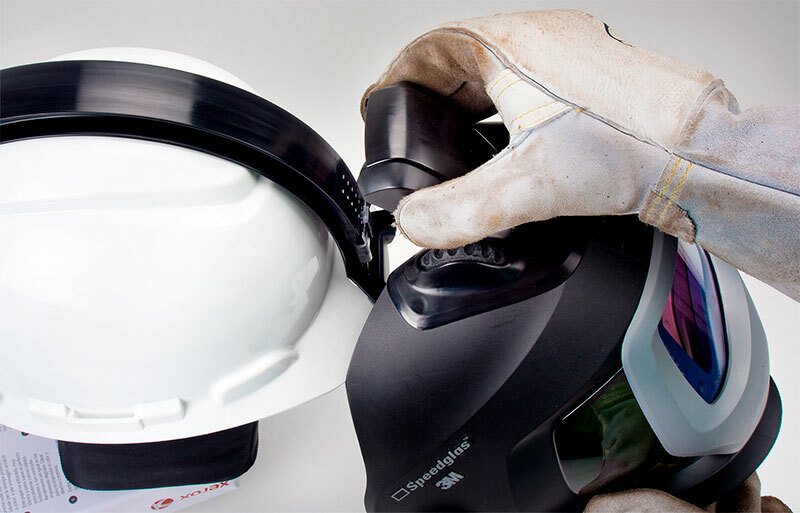
Understanding the main criteria of this important accessory, it is possible to identify the optimal values for specific types and operating conditions:
1. For dacha or amateur welding in the garage, a mask with a window 90x32 mm, a light filter No. 4, made of pressed cardboard.
2. For the welding of heating or water supply, the review model 100x90 mm is useful, with a light filter No. 3, convenient for indoor use, weighing 400 grams and a foam layer on the mount. Housing material - plastic. It's good to buy a product with a folding glass.
3. To make stainless steel, you will need a chameleon with DIN 8-13, weight 500 g, distortion of the lens 1 and transparency 2. It is desirable to have a solar battery and a foam pad.
4. Fine welds with a non-consumable electrode on a metal of 1 mm or less will be conveniently cooked in a chameleon with a lens 1 and a transparency parameter of 1. The light-darkening range is 5-15 DIN, the solar panel and 600 g weight.
5. For work inside the tanks you need a mask with forced air supply and a viewing window 90x60 mm, DIN 5-13.
How much does the welding mask

Understand the fine relationship between the mask parameters and the convenience of the welding process, it is really worthwhile to note the approximate cost of each accessory for specific types of work:
1. To give a simple protective device will have a price of 200-400 rubles.
2. To work on the construction of heating or pipelines, you will have to buy a mask for 400-800 rubles.
3. For welding stainless steel of ordinary thickness, the accessory will cost 1100-1600 rubles.
4. To make it comfortable to work with thin metals, you need a mask for 1400-4000 rub.
5. The model with forced air supply costs 42000-180000 rub.

